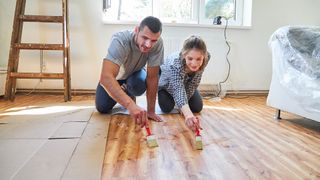Other types of flooring can be kept in good condition using the best steam mops, (opens in new tab) but when it comes to hardwood, sealing is the best way to maintain the floor’s quality and appearance.
Why you should seal hardwood floors
Sealing hardwood floors gives the flooring surface a protective barrier that can withstand damage from daily use. This cuts down on maintenance and will help wooden flooring last for longer. Older hardwood floors are often unfinished, so if you live in a period property and want to check if your floor is sealed, try placing a small drop of water onto one of the boards. If the droplet remains on the surface, the floor has been sealed. However, if the water is absorbed, the flooring is either unsealed or the sealant has worn away – and it’s time to learn how to seal hardwood floors.
How to seal hardwood floors with oil
According to Goodell David, Founder of WoodWorking Clarity (opens in new tab), “The average lifespan of hardwood floors is about 100 years, but it won’t last that long without a sealant.” To seal a hardwood floor with oil;
- Start with sanding Sand the floor to remove any traces of other products. Use a damp cloth to remove any sanding dust or other debris.
- Begin oiling Starting in the corner farthest from the doorway, pour the oil onto the floor and use a rag to wipe it in the direction of the floorboards. Remove any excess with a clean cloth.
- Re-apply and leave to dry Apply at least two coats of oil, leaving 24 to 48 hours between application to allow for the first coat to dry.
How to seal hardwood floors with polyurethane
When practicing how to seal hardwood floors with polyurethane, open a window to keep the room well-ventilated. To seal hardwood floors with polyurethane;
- Pour the polyurethane Decant a line of polyurethane along the wall farthest from the door, then drag a flooring applicator through the sealant and across the floor, moving from one wall to the other. Repeat to cover the entire surface, keeping the applicator on the floor to prevent bubbles.
- Leave to dry Allow the sealer to dry – two hours for water-based polyurethane, and 10 to 24 hours for oil-based polyurethane.
- Re-apply if necessary Apply up to three additional coats. Goodell David explains, “If you notice imperfections after the first coat, you should sand then clean as usual. However, not all brands require sanding between coats.” Discover more guides for the home… Best steam mops (opens in new tab) Best robot vacuums (opens in new tab) Best handheld vacuums (opens in new tab) Best carpet cleaners (opens in new tab)





